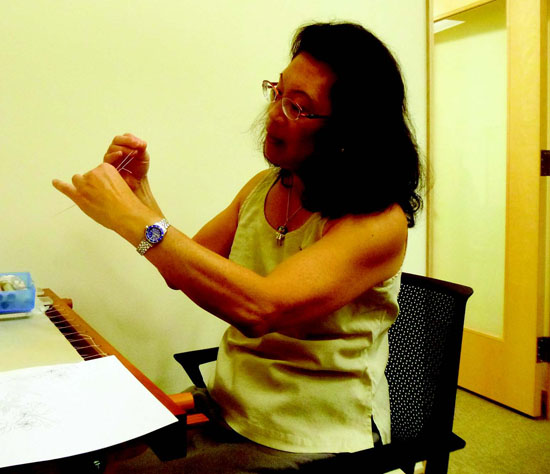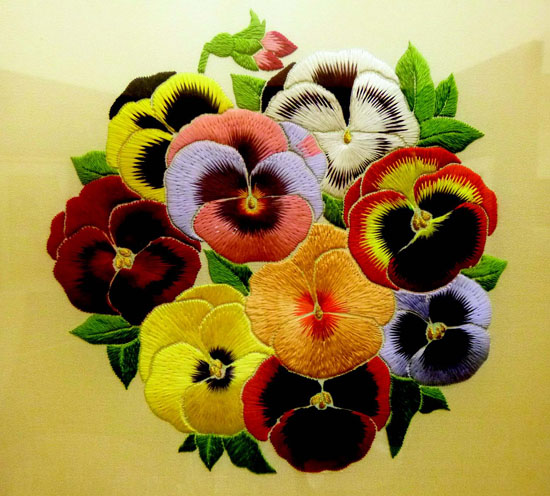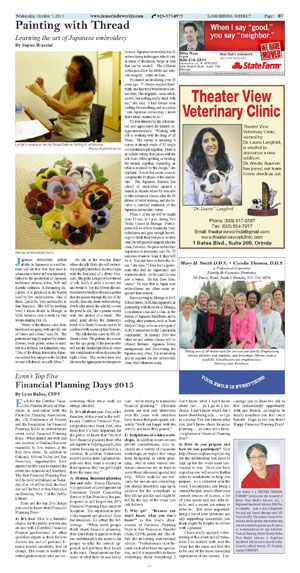|
|
Published October 7th, 2015
|
Painting with Thread
|
| Learning the art of Japanese embroidery |
| By Sophie Braccini |
 |
| Lynda Fu prepares her silk thread before starting to embroider. Photos Sophie Braccini |
Japanese embroidery (nihon shishu in Japanese) is a millennium-old art that was first used to adorn sacred items and was intimately linked to the production of Japanese traditional dresses, robes, Noh and Kabuki costumes. A demanding discipline, it is practiced at the higher level by few embroiderers. One of them, Lynda Fu, lives and teaches in San Francisco. She will be teaching level 1 nihon shishu in Moraga, at BDK America, once a week for four weeks starting Oct. 23.
 "Many of the themes come from traditional imagery, with specific use of forms and colors," says Fu. The patterns are largely inspired by nature: flowers, birds, plants, water or wind, but in a stylized, yet naturalistic way. "One of the things that makes Japanese embroidery unique is the fact that we use silk thread on a silk fabric."
"Many of the themes come from traditional imagery, with specific use of forms and colors," says Fu. The patterns are largely inspired by nature: flowers, birds, plants, water or wind, but in a stylized, yet naturalistic way. "One of the things that makes Japanese embroidery unique is the fact that we use silk thread on a silk fabric."
 Fu sits at the wooden frame where the silk fabric she will embroider is tightly stretched, about to begin with the first petal of a cherry blossom. She picks a single yellow thread of silk, holds it, pulls a second one and twists it. For this flower, the embroiderer twists three threads together that she passes through the eye of the needle; then she starts embroidering. Stitch after stitch, she adroitly covers the petal in silk, like a painter would with fine strokes of a brush. The small petal shows the distinctive notch of a cherry blossom, not to be confused with a round plum blossom.
Fu sits at the wooden frame where the silk fabric she will embroider is tightly stretched, about to begin with the first petal of a cherry blossom. She picks a single yellow thread of silk, holds it, pulls a second one and twists it. For this flower, the embroiderer twists three threads together that she passes through the eye of the needle; then she starts embroidering. Stitch after stitch, she adroitly covers the petal in silk, like a painter would with fine strokes of a brush. The small petal shows the distinctive notch of a cherry blossom, not to be confused with a round plum blossom.
 The silk threads come in 500 different colors. The pattern, the season and the age group of the person who will use the finished product all come into consideration when choosing the right colors. The embroiderer also chooses the appropriate techniques to be used. Japanese embroidery has 43 embroidering techniques, which vary in terms of thickness, bulge or dots that can be created. The different techniques allow for subtle and intricate imagery - a true art form.
The silk threads come in 500 different colors. The pattern, the season and the age group of the person who will use the finished product all come into consideration when choosing the right colors. The embroiderer also chooses the appropriate techniques to be used. Japanese embroidery has 43 embroidering techniques, which vary in terms of thickness, bulge or dots that can be created. The different techniques allow for subtle and intricate imagery - a true art form.
 Fu started embroidering over 30 years ago. "I always enjoyed handwork, and had tried western style embroidery, like trapunto, cross-stitch, crewel, but nothing really stuck with me," she said. "I had always been looking for something, and as soon as I saw Japanese embroidery I knew that's what I wanted to do."
Fu started embroidering over 30 years ago. "I always enjoyed handwork, and had tried western style embroidery, like trapunto, cross-stitch, crewel, but nothing really stuck with me," she said. "I had always been looking for something, and as soon as I saw Japanese embroidery I knew that's what I wanted to do."
 Fu was attracted to the silk material and appreciated the natural designs tremendously. "Working with silk is working with the king of all fibers. The variety is amazing; it comes in strands made of 12 single cocoon threads put together. There is an infinite variety that comes with the silk from either splitting or twisting the strands together, depending on what is required by the design," she explains. It took her seven years to complete the 10 phases of the curriculum. The Japanese Kurenai Kai school of embroidery opened a branch in Atlanta where Fu was able to take advanced classes after the 10 phases of initial training, and she became a certified instructor of the Japanese embroidery center.
Fu was attracted to the silk material and appreciated the natural designs tremendously. "Working with silk is working with the king of all fibers. The variety is amazing; it comes in strands made of 12 single cocoon threads put together. There is an infinite variety that comes with the silk from either splitting or twisting the strands together, depending on what is required by the design," she explains. It took her seven years to complete the 10 phases of the curriculum. The Japanese Kurenai Kai school of embroidery opened a branch in Atlanta where Fu was able to take advanced classes after the 10 phases of initial training, and she became a certified instructor of the Japanese embroidery center.
 Phase 1 of the art will be taught from 10 a.m. to 3 p.m. during Fu's Friday classes in Moraga. Participants will be able to master the basic techniques and gain enough knowledge to finish their first piece on their own; Fu will provide support after the class, if needed. No prior embroidery experience is necessary, says Fu. "If someone wants to learn it, they will do it. You just have to have the desire," she says. "I have had a gentleman who had no experience and wanted to study. All he could do was sew a button. He has done fabulously." Fu says that in Japan men embroiderers are often more respected than women.
Phase 1 of the art will be taught from 10 a.m. to 3 p.m. during Fu's Friday classes in Moraga. Participants will be able to master the basic techniques and gain enough knowledge to finish their first piece on their own; Fu will provide support after the class, if needed. No prior embroidery experience is necessary, says Fu. "If someone wants to learn it, they will do it. You just have to have the desire," she says. "I have had a gentleman who had no experience and wanted to study. All he could do was sew a button. He has done fabulously." Fu says that in Japan men embroiderers are often more respected than women.
 Since moving to Moraga at 1675 School Street, BDK has organized, in partnership with the town of Moraga, a meditation class and a class on the history of Japanese Buddhism, and is seeking other partners, such as Saint Mary's College, to be an active part of BDK's endeavors in the Lamorinda community. In January 2016 two other art and culture classes will be offered: Ikebana - Japanese flower arrangement; and discovering the Japanese way of tea. For information and to register for the embroidery class, visit www.bdkamerica.org.
Since moving to Moraga at 1675 School Street, BDK has organized, in partnership with the town of Moraga, a meditation class and a class on the history of Japanese Buddhism, and is seeking other partners, such as Saint Mary's College, to be an active part of BDK's endeavors in the Lamorinda community. In January 2016 two other art and culture classes will be offered: Ikebana - Japanese flower arrangement; and discovering the Japanese way of tea. For information and to register for the embroidery class, visit www.bdkamerica.org.

|
 |
| Pansies embroidered by Fu |
|
|
|
|
|
|
|
|
|
|
|




